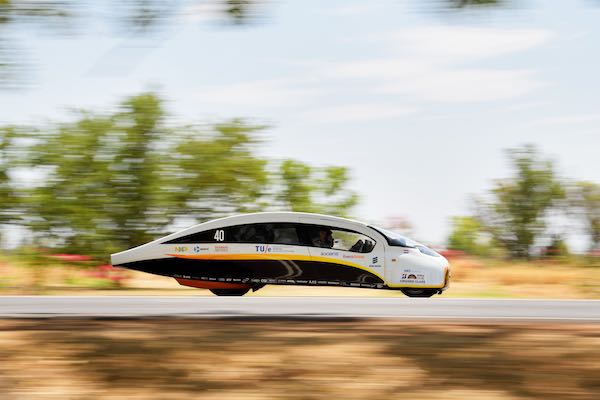
[Image above] Credit: Solar Team Eindhoven; Flickr CC BY-NC-ND 2.0
An epic race is underway on the other side of the world as I write this—and it’s being fueled by the sun.
Forty-two solar-powered vehicles are currently competing with one another in the World Solar Challenge, a long-distance solar vehicle race across the Australian continent.
The 1,865-mile journey from Darwin, on the north coast of Australia, south to Adelaide began Sunday and officially continues through the week.
The competition, mostly entered by university- and corporation-based teams from around the world, entails teams building their own solar vehicles and driving them on a self-sufficient, multi-day intercontinental trek. The Challenge occurs every other year.
Teams entered in the challenge must rely almost entirely on the sun to provide enough energy to power vehicles from start to finish lines. However, cars can also harness kinetic energy from the vehicles’ motion, too, and teams can equip their cars with the capability to store a small percentage of energy.
During the race, teams drive during daytime hours only, camping alongside the road at night. There are seven checkpoints along the journey where basic vehicle maintenance is allowed—otherwise, teams are on their own.
The first cars are expected to cross the finish line on Thursday, based on past race performance. Tokai University currently holds the world record for quickest completion of the journey, which its team set in 2009 at just 29 hours and 49 minutes.
And this year, there’s no reason to expect teams to be slower—in fact, there’s reason to think a new world record might be set.
“This year, the race regulations are a clear sign of how rapidly solar technology is changing,” according to an Engadget article. “Teams have to use a smaller solar collector than before: cars in the Challenger class can have no more than 43 square feet of solar cells versus nearly 65 square feet for the previous race, in 2015. That’s half the area allowed on cars from the original 1987 race. In other words, technology is advanced enough now (both in solar cells and the underlying vehicle designs) that you don’t need a sea of panels to keep a car running.”
Although the competition showcases odd-looking cars and state-of-the-art technology that may never enter the passenger vehicle market, it does serve as a demonstration of some of the most advance solar-powered tech currently available. “These are arguably the most efficient electric vehicles,” according to the World Solar Challenge website.
“Of course, the point of this challenge is not just to go fast, or to develop technology that will never reach the mainstream,” event director Chris Selwood says in an ECN article. “Our founder, Hans Tholstrup, and competitors past and present, are all determined to make sustainable, energy positive, solar electric cars and renewable technology a reality.”
Although the majority of technology in today’s consumer electric vehicles isn’t solar-based, some of the engineering and technology principles hold true across electric vehicles, at least as a contrasting shift away from the internal combustion engine. Plus, some automakers are already incorporating auxiliary solar features into current models, such as Audi’s solar-integrated glass roof.
Nonetheless, the reality of electric cars powered by renewable technology is becoming less and less difficult to imagine in the very near future. Many automakers have already made rather drastic shifts towards lowering vehicles’ emissions and an electrified future.
Most recently, GM announced that it’s heading swiftly towards a zero-emissions future, which will include both battery-based and fuel cell vehicles. That’s rather drastic and a telling indication of the future of the automobile market, coming from a company that was built upon the internal combustion engine.
Head over to the World Solar Challenge website to see the race results and track the teams across Australia. And BBC has some great images from this year’s race so far.
Did you find this article interesting? Subscribe to the Ceramic Tech Today newsletter to continue to read more articles about the latest news in the ceramic and glass industry! Visit this link to get started.
Author
April Gocha
CTT Categories
- Energy
- Environment
- Transportation


